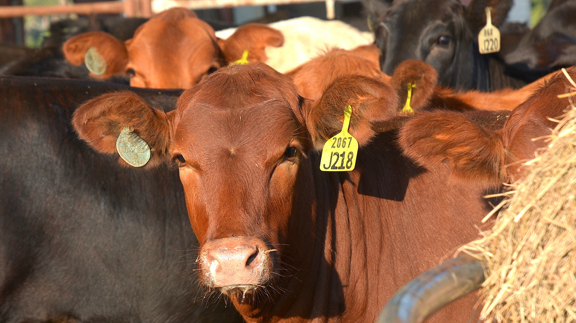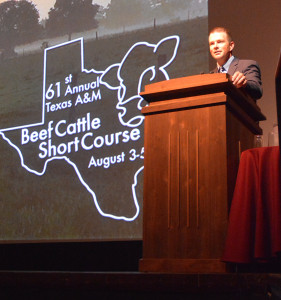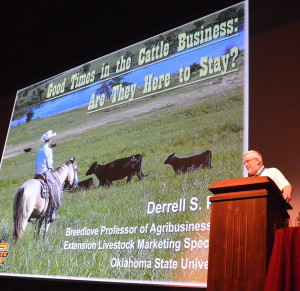Farm & Ranch
‘Exciting_times’_in the cattle business moving forward

By: Blair Fannin
Texas A&M Beef Cattle Short Course features cattle market outlook, trends
Writer: Blair Fannin, 979-845-2259, [email protected]
COLLEGE STATION – As temperatures in College Station reached 100 degrees during Monday’s opening general session of the 61st Texas A&M Beef Cattle Short Course, it could also accurately describe a red-hot cattle market the past two years.
“These are exciting times indeed, but are they here to stay?” said Dr. Jason Cleere, conference coordinator and Texas A&M AgriLife Extension beef cattle specialist, addressing one of the highest-attended short course events ever.
More than 1,680 beef cattle producers gathered at Texas A&M to hear the latest about the cattle market and future trends.
“I think there is a lot to look forward to down the road,” Cleere told attendees.
Dr. Derrell Peel, Oklahoma State University livestock marketing economist, said the cattle market may have topped earlier this year, but don’t expect a downward spiral in prices anytime soon. However, Peel said to “prepare for lower prices” according to decades of past charts and data.
“It’s been fun on the way up; it’s been easy to make money on the way up,” Peel said. “There still will be some good times ahead, but you’re going to have to manage costs in relation to the market. It all goes back to cost management. Now is a good time to invest some of those good returns you’ve had to help manage costs over the next few years. That might be investing in (replacement) females or brush control. I’m still optimistic. The best cure for high prices is high prices.”
According to the latest U.S. Drought Monitor, Peel said, drought conditions have improved dramatically and beef producers “have been able to switch from defense to offense” in building back herds.
“We are on the way back to seeing expansion,” Peel said.
U.S. cattle inventory was up 2.5 percent as of July 1, according to the U.S. Department of Agriculture-National Agricultural Statistics Service. Beef cow numbers totaled 30.5 million July 1 as compared to 29.7 million in 2014.
Other indicators include a 6.9 percent decline in cattle slaughter so far for 2015 as well as an 11.5 percent decline in heifer slaughter.
“That’s pretty strong evidence we are expanding,” Peel said.
Dr. Rick Machen, AgriLife Extension livestock specialist, Uvalde, discussed emerging issues in the beef industry. He said the recent ban lifted on imports from Argentina and Brazil will weigh on U.S.-produced grass-fed and organic beef markets.
“It’s quite likely some of these imports could compete one-on-one with some of the products you produce here,” Machen said. He advised those who produce grass-fed and organic beef in Texas and abroad to manage costs and keep a watchful on the issue as it could affect business.
When it comes to food and beef, Millennials, those born in the 1980s or 1990s, they want to know who raised it, how it was treated, where it came from, whether it contains genetically modified organisms, the environmental impact and whether it is sustainable.
“They want somebody that is tied to agriculture, somebody they can trust to answer their questions,” Machen said. “There is nobody better to tell our story than us.”
Machen encouraged beef producers to tell their story about stewardship and stockmanship and “tell it as often as you can.”
“Tell your grandkids to invite their friends to come out the ranch and tell your story. How we help the Millennials, the kids they are raising, is going to have a profound influence on who is inheriting the ranch on down the line.”
Other general session speakers included Russell Woodward, senior manager of product marketing with the Texas Beef Council, Dan Halstrom, senior vice president of global marketing and communications with the U.S. Meat Export Federation, and Brian Bledsoe, Colorado-based meteorologist featured monthly in the Southern Livestock Standard.
This year’s short course was dedicated to Dr. David Bade, AgriLife Extension state forage specialist emeritus. Bade thanked the many beef cattle producers he has worked with throughout his career and for receiving the honor during Monday’s traditional prime rib dinner held at the Memorial Student Center on the Texas A&M campus. The dinner also featured remarks by Texas A&M System Chancellor John Sharp and Texas A&M President Michael K. Young.
The event showcases the latest research and educational programs offered by AgriLife Extension, Texas A&M AgriLife Research and the department of animal science at Texas A&M. The annual event is one of the largest beef-education workshops in the country, according to organizers.
-30-
Find more stories, photos, videos and audio at http://today.agrilife.org
Farm & Ranch
Acorn Toxicity

By Barry Whitworth, DVM, MPH
With the prolonged drought, most pastures in Oklahoma end up in poor condition. With the lack of available forage, animals may go in search of alternative foods.
If oak trees are in the pastures, acorns may be a favorite meal for some livestock in the fall. This may result in oak poisoning.
Oak leaves, twigs, buds, and acorns may be toxic to some animals when consumed.
To read more, pick up a copy of the November edition of North Texas Farm & Ranch magazine, available digitally and in print. To subscribe by mail, call 940-872-5922.

Farm & Ranch
Silver Bluestems

By: Tony Dean
There are a handful of grasses on North Texas grazing lands ranchers need to know, not because they are highly desirable, but rather because they are not of much value. I call them “decom” plants, which is am acronym for “Don’t Ever Count On Me.” Silver bluestem is a “decom” grass.
Silver bluestem is a perennial which grows in all areas of Texas. It can survive in almost all soil types, and in full sun conditions or in semi shade. It grows up to three feet tall and is easily recognized with the presence of the white fuzzy seed head. Also, one of the identifying characteristics of Silver bluestem is a bend in the stems at each node, causing the plants to take on a rounded shape as they mature.
To read more, pick up a copy of the November edition of North Texas Farm & Ranch magazine, available digitally and in print. To subscribe by mail, call 940-872-5922.

Farm & Ranch
Meanwhile Back At The Ranch

By: Rayford Pullen
Fall is here which means winter is closing in on us and before we officially get into winter, we need to make sure our factories are either producing or will be producing in a few months.
We have been pregnancy testing our cows this fall and if they are not bred or nursing a calf, we are bidding them adios. With annual costs somewhere between $900.00 and $1,000.00 per cow, those cows not producing a live weaned calf are costing us quite a bit.
To read more, pick up a copy of the November edition of North Texas Farm & Ranch magazine, available digitally and in print. To subscribe by mail, call 940-872-5922.
-

 Country Lifestyles2 years ago
Country Lifestyles2 years agoScott & Stacey Schumacher: A Growth Mindset
-

 Country Lifestyles8 years ago
Country Lifestyles8 years agoStyle Your Profile – What your style cowboy hat says about you and new trends in 2017
-

 HOME8 years ago
HOME8 years agoGrazing North Texas – Wilman Lovegrass
-

 Equine1 year ago
Equine1 year agoThe Will to Win
-

 Country Lifestyles5 years ago
Country Lifestyles5 years agoAmber Crawford, Breakaway Roper
-

 Outdoor9 years ago
Outdoor9 years agoButtercup or Primrose?
-

 Country Lifestyles8 years ago
Country Lifestyles8 years agoJune 2016 Profile – The man behind the mic: Bob Tallman
-

 Country Lifestyles8 years ago
Country Lifestyles8 years agoDecember 2016 Profile, Rusty Riddle – The Riddle Way






